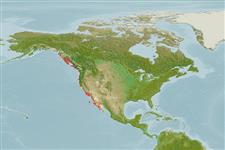Environment: milieu / climate zone / depth range / distribution range
Ecologia
marino; oceanodromo (Ref. 51243); distribuzione batimetrica 0 - 18 m (Ref. 2850). Temperate; 58°N - 24°N, 155°W - 111°W
Eastern Pacific: Alaska to Magdalena Bay, Baja California. Not common north of Point Conception (Ref. 11484).
Size / Peso / Age
Maturity: Lm ? range ? - ? cm
Max length : 145 cm FL maschio/sesso non determinato; (Ref. 40637); peso massimo pubblicato: 12.0 kg (Ref. 40637); Età massima riportata: 12 anni (Ref. 56049)
Spine dorsali (totale): 6; Raggi dorsali molli (totale): 9-10; Spine anali 1; Raggi anali molli: 8 - 9. Color bluish or brownish dorsally, silvery ventrally (Ref. 6885).
Usually near shore or near the surface (Ref. 2850). Often in small schools (Ref. 2850). Young enter bays (Ref. 2850). Feed mainly on other fishes (Ref. 2850). Pelagic spawners (Ref. 56049). Migrate south from the California coast during autumn, but may remain in front of the Mexican coast throughout the year (Ref. 9345). Utilized fresh, dried or salted and frozen; eaten broiled and baked (Ref. 9988). Considered as potentially dangerous due to its large, sharp teeth and aggressive disposition, though there are no reports of attacks (Ref. 9988).
Pelagic spawner (Ref. 56049).
Eschmeyer, W.N., E.S. Herald and H. Hammann, 1983. A field guide to Pacific coast fishes of North America. Boston (MA, USA): Houghton Mifflin Company. xii+336 p. (Ref. 2850)
IUCN Red List Status (Ref. 130435)
Threat to humans
Traumatogenic (Ref. 13513)
Human uses
Pesca: commerciale; Pesce da pesca sportiva: si
Informazioni ulteriori
CollaboratoriImmaginiStamps, Coins Misc.SuoniCiguateraVelocitàModalità di nuotoArea branchialeOtolithsCervelliVista
Strumenti
Special reports
Download XML
Fonti Internet
Estimates based on models
Preferred temperature (Ref.
123201): 8.9 - 23.1, mean 12.4 °C (based on 212 cells).
Phylogenetic diversity index (Ref.
82804): PD
50 = 0.5000 [Uniqueness, from 0.5 = low to 2.0 = high].
Bayesian length-weight: a=0.00724 (0.00339 - 0.01546), b=2.92 (2.74 - 3.10), in cm total length, based on LWR estimates for this Genus-body shape (Ref.
93245).
Trophic level (Ref.
69278): 4.5 ±0.80 se; based on food items.
Generation time: 7.9 ( na - na) years. Estimated as median ln(3)/K based on 1
growth studies.
Resilienza (Ref.
120179): Medio, tempo minimo di raddoppiamento della popolazione 1.4 - 4.4 anni (K=0.14; tm=2-3; tmax=12; Fec=42,000).
Fishing Vulnerability (Ref.
59153): High to very high vulnerability (69 of 100).
